 You?ll be wishing for the Little Nicky storyline after watching this movie.
You?ll be wishing for the Little Nicky storyline after watching this movie.
Twin Peaks: Fire Walk With Me can be an unpleasant viewing experience. Stripping away the quirky humor and surreal soap opera subplots of the series, the film mainlines us straight into the dark heart of Laura Palmer, showing a young woman living in a nightmare world of horrific abuse. The movie is also somewhat less available than its television counterpart (i.e., not bundled with the rest of the series on Netflix), meaning David Lynch?s prequel unfortunately tends to get skipped by people binge-watching the show. Moreover, The Missing Pieces, a feature length compilation of deleted scenes from FWWM, is only available on the Twin Peaks Blu-ray set. Apparently these scenes have some bearing on what is to come, and for many reasons are essential viewing for the Twin Peaks fan.
So, for those who either can?t bring themselves to watch or rewatch the film, or won?t be able to catch it before the new episodes air, and for those who haven?t seen the deleted scenes and are wondering what cosmic details are revealed therein, here is presented to you a handy and concise guide. Please note: this is simply a breakdown of various story revelations, literal plot points, and mythology. This is NOT a dive into the story?s deeper symbolic meaning, or a blow-by-blow overview of either Fire Walk With Me or The Missing Pieces. Please still watch them, if you can. But if you can?t . . .
Let?s rock!
Teresa Banks, the first victim
Teresa was a 17-year old drifter who lived at the Fat Trout Trailer Park near Deer Meadow, Washington, and moonlighted as a prostitute to help support her drug habit. Leland Palmer/BOB discovered her in the back pages of Fleshword magazine, and started seeking Teresa?s services while on business trips. They arranged to have a sex party with some of her friends, but when Leland arrived at the chosen motel, he saw that Teresa?s friends were Ronette Pulaski and his own daughter Laura. Horrified, he ran away before they could see him. Teresa made some calls and pieced together that Leland was Laura?s father, so she attempted to blackmail him, unsuccessfully. Leland later beat her to death in her trailer, dumping Teresa Banks? plastic-wrapped body in Wind River.
 Teresa is banking on getting some dough from Leland.
Teresa is banking on getting some dough from Leland.
The investigation
Teresa?s murder was investigated by Special Agent Chester ?Chet? Desmond (Chris Isaak) and the perpetually nervous Agent Sam Stanley (Kiefer Sutherland). Both of them were hand-picked by Gordon Cole to steer the investigation. Deer Meadow proves to be like a horrific funhouse version of Twin Peaks: the police force is unhelpful and possibly corrupt, the local diner is a freakshow, and the town in general just a grimy, rotting, forgotten place. Agent Desmond himself is the opposite of Cooper . . . cocky, secretive, a prankster, and occasionally combative, but the perfect agent to deal with the antagonistic people of Deer Meadow. The investigation turned up no suspects and no real leads.
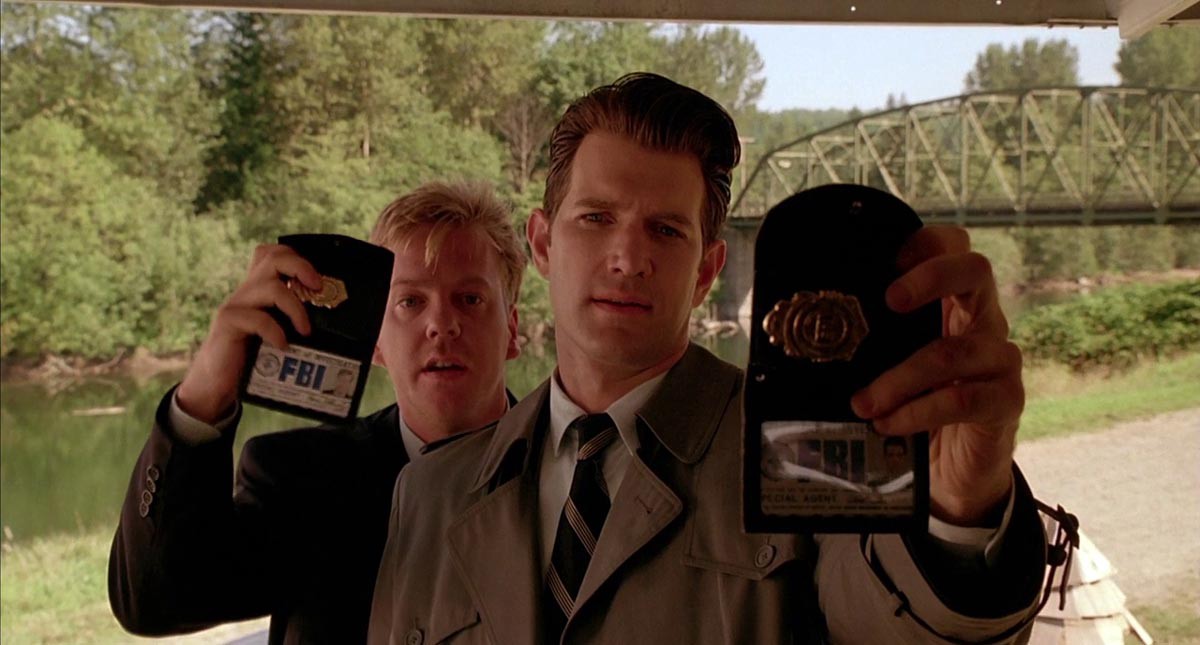 Sam Stanley and Chet Desmond, FBI. Have you seen a wicked game in the area?
Sam Stanley and Chet Desmond, FBI. Have you seen a wicked game in the area?
The Blue Rose
The film reveals that Gordon Cole has a special designation for certain cases of an unusual variety, classified as Blue Rose cases. Agent Stanley does not have the clearance to know what a Blue Rose case is, and when he asks Agent Desmond, Chet refuses to answer. Teresa?s murder is designated a Blue Rose case, as is presumably Laura?s a year later. There also appears to be some connection between the Blue Rose and Major Briggs? Project Blue Book from the series, both in the reference to the color blue and also in the supernatural nature of the investigations.
The ring
Before her murder, Teresa had been wearing a blue ring engraved with the symbol from Owl Cave. The ring vanished after her death. Agent Desmond later saw the ring at the trailer park, sitting on a mound of dirt similar to the one later found at Laura Palmer?s murder scene. When Desmond reached for the ring, he disappeared and was never seen again. This ring may be synonymous with whatever the Blue Rose is meant to represent. More on the ring shortly.
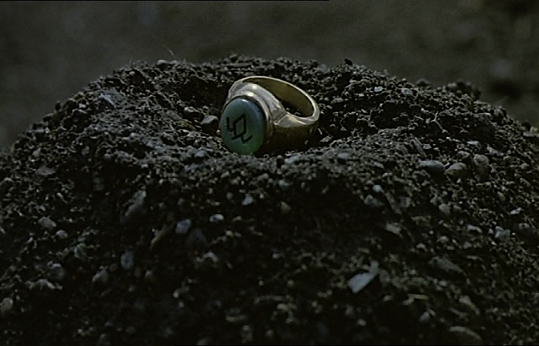 The Blue Rose, or just a really creepy way of proposing?
The Blue Rose, or just a really creepy way of proposing?
The Black Lodge
Both the movie and the deleted scenes deepen the mythology of the Lodges considerably. As established on the series, BOB and the Little Man are from the Lodge. The movie also reveals that the mysterious Old Woman and her Grandson seen on the show (they were identified as the Tremonds, but this was not their real surname) hail from the Lodge as well. Newly introduced characters include the Electrician, the Woodsmen, and the Jumping Man.
Essentially, it is implied that these beings come from another world, and they materialize in our reality by manipulating electrical currents/electromagnetic energy. They are fascinated and amused by our earthly existence. These aliens/spirits feed off of human experience: BOB thrives on fear and indulgence; the Little Man, meanwhile, lives on something he calls garmonbozia, his word for pain and suffering. Garmonbozia takes the form of creamed corn, which is why on the series the Old Woman found the image of creamed corn unsettling. The Lodge beings influence and use humans for their own purposes. It is unclear if these unearthly figures actually originated from the White/Black Lodge, or if those spaces are an intermediary between our world and whatever world they come from.
 Left to right (background): the Jumping Man, the Electrician, the Tremonds/Chalfonts, Woodsman #2, Woodsman #1. Foreground: the Little Man, special guest star garmonbozia/creamed corn, and BOB.
Left to right (background): the Jumping Man, the Electrician, the Tremonds/Chalfonts, Woodsman #2, Woodsman #1. Foreground: the Little Man, special guest star garmonbozia/creamed corn, and BOB.
The Fat Trout Trailer Park seems to be a source of Lodge activity. There, the Old Woman and her Grandson had been living under the name Chalfont until Teresa?s death. The park?s manager, the extremely gruff Carl Rodd (Harry Dean Stanton), is strongly suggested to have visited the Lodge(s), when he hauntingly tells Desmond and Stanley ?I?ve already gone places. I just want to stay where I am.?
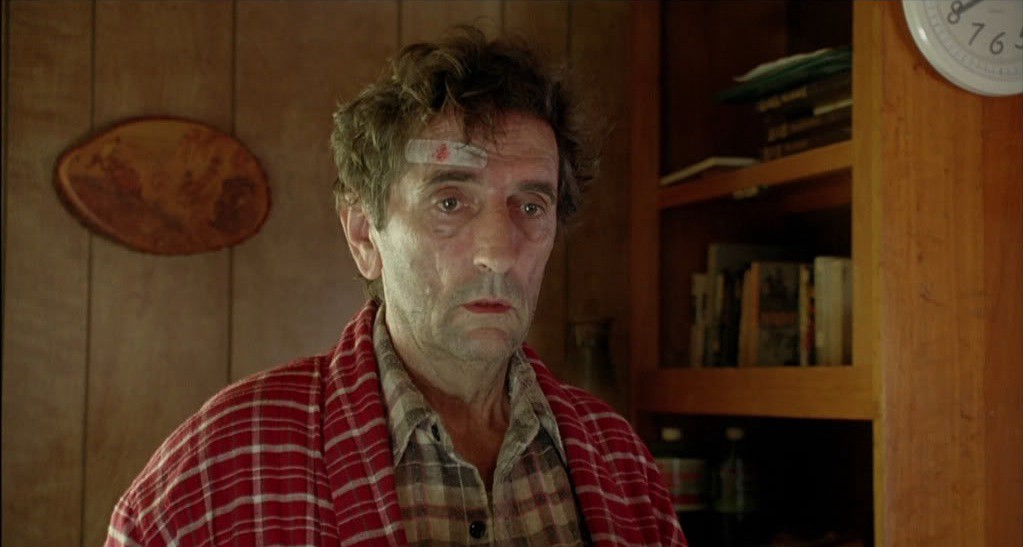 ?I?ve already gone places. On the Nostromo.?
?I?ve already gone places. On the Nostromo.?
After Agent Desmond goes missing, Cooper is sent to Deer Meadow to find him. At the trailer park, Coop discovers Desmond?s abandoned vehicle. On the windshield of the car, someone has written in lipstick ?Let?s Rock,? the very first words that the Little Man says to Cooper in his dream on the series.
Phillip Jeffries
One of the most intriguing new additions is the character of Phillip Jeffries (played by David Bowie). Jeffries had been investigating a Blue Rose case in Seattle, involving someone named Judy and the aforementioned ring. The trail lead him to a place above a convenience store, where he witnessed a meeting between BOB, the Little Man, etc., and then presumably followed them into the Lodge. He?s never been heard from since . . . until he appears out of thin air in Philadelphia two years later, where he tries to explain to Cole, Cooper, and Albert what happened to him, before vanishing again. The deleted scenes further reveal that before his sudden appearance in Philly, Jeffries had been checking into a hotel in Buenos Aires. Apparently, his venturing into the Lodge has turned him into a walking electromagnetic distortion in space and time, causing Jeffries to involuntarily use the power of the Lodge to teleport/time travel at random moments.
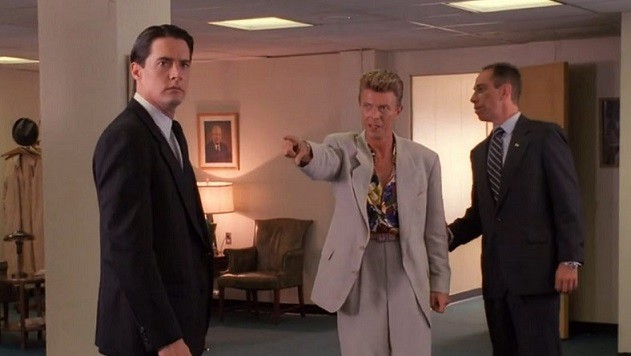 Jeffries attempts to tell his story. Cooper is not amused.
Jeffries attempts to tell his story. Cooper is not amused.
Laura Palmer
Most of the movie centers around the shame, self-hatred, and death wish of the secretly suffering Laura Palmer. The film also clarifies how broken the Palmer household actually was: Leland could be terrifying at home, and Sarah was constantly on the verge of a nervous breakdown precisely because she knew what was happening in her family but found herself unable to acknowledge or stop it.
A few days before her death, Laura experienced a strange dream where she entered the Red Room, and the Little Man attempted to give her the ring. Cooper, also somehow in the Red Room, warned her from taking it. Laura awoke to see a vision of Annie Blackburn lying next to her, appearing exactly as Annie does in the final episode, wearing the floral dress and with blood coming out of her nose. Annie gives Laura a message: ?The good Dale is in the Lodge, and he can?t leave. Write it in your diary.?
 ?I did NOT have fun at the Miss Twin Peaks Contest. I did NOT.?
?I did NOT have fun at the Miss Twin Peaks Contest. I did NOT.?
On the night of her death, Laura chooses to die. In the train car, the ring again appears to her, and this time she puts it on. BOB/Leland screams ?Don?t make me do this!? before killing her. Laura allowed herself to die because she was afraid of ending up like her father; she felt the corruption of BOB growing within her, and indeed, BOB wanted Laura as his new host. The deleted scenes also hint that Laura was beginning to become a conduit for the occult power of the Lodge.
The One-Armed Man
BOB?s former partner in crime, Mike/the One-Armed Man, turns out to be one and the same with the Little Man From Another Place. The Little Man refers to himself as ?the Arm? . . . he is the evil/negativity that Mike tried to sever. But Mike is still secretly addicted to pain and suffering. After trying and failing to stop Leland/BOB from killing Laura, the One-Armed Man wandered into the Lodge, clearly under the control of the Little Man, where he demanded from BOB his garmonbozia.
 He did it all for the garmonbozia.
He did it all for the garmonbozia.
Special Agent Dale Cooper
Some of the deleted scenes actually take place after the series ends. We see Annie being rushed to the hospital following her escape from the Black Lodge, covered in blood. On her finger is the Lodge ring, later stolen by a nurse. Meanwhile in the Lodge, it becomes obvious that Cooper is trapped in a place beyond time. He was able to interact with Laura in her dream because the Lodge exists outside of linearity; he?s in both the past and future simultaneously, neither here nor there. Back in his hotel room, Cooper?s doppelganger is laughing maniacally when Sheriff Truman and Doc Hayward burst in. Evil Coop describes smashing his own head in the mirror: ?It struck me as funny, Harry. Do you understand me? It struck me as funny.? This is the furthest the narrative has gone, until now.
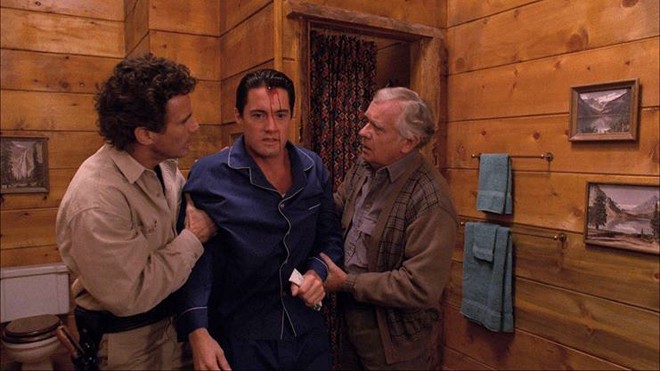 Cooper and Annie are super into bleeding.
Cooper and Annie are super into bleeding.
The White Lodge
The final scene of the movie depicts Laura sitting in the Red Room after her death, comforted by Cooper as her soul watches an angel floating in the air, an image of innocence from her childhood. Though most of the characters/beings commonly thought to be associated with the White Lodge are absent from the film (the Giant, the Waiter, the Hooded Guardian, the Owl), this moment of spiritual fulfillment hints that the White and Black Lodge might really be the same place, and that it?s simply a matter of perception (love/fear) which dictates the experience.
Some additional highlights:
- Sam Stanley is the pathologist mentioned in the pilot, when Cooper says to Diane ?Take this to Albert, don?t go to Sam.?
- Supposedly, the writers had been playing with an idea that BOB and the Little Man/Mike are from a planet literally made of creamed corn. There was also originally an opening scene set in the 50s, showing BOB and Mike in the room above the convenience store as they listened to a speech by Eisenhower. It was scrapped before production.
- Mark Frost?s new Twin Peaks book ? though the information revealed in it might be questionable ? does explain that Carl Rodd, along with the Log Lady, was abducted by the mysterious forces of Ghostwood Forest when they were both children.
- A discussed but never-filmed backstory for Jeffries is that he was in Buenos Aires to meet with Judy and with Windom Earle. This is before Windom?s stint in the asylum, and when he?s still searching for a door to the Lodge. Judy was going to turn out to be Josie?s twin sister who lived in Seattle, clarifying why Josie was always taking off to Seattle whenever things got dicey at home. This would also explain the role the Black Lodge inhabitants later played in Josie?s strange death on the series.
- In the pilot, James mentions that Bobby supposedly killed someone. The movie finally offers an answer: Bobby and Laura had a failed drug transaction in the woods near the mill. The dealer turned out to be a cop (a deputy from Deer Meadow, in fact), and a surprised Bobby drew a gun and shot him. Bobby and Laura left the deputy half-buried in the woods.
- Annie?s ?write it in your diary? message to Laura was intended to help set up the resolution of the Cooper/BOB plotline, should the story be continued.
- There is a deleted scene where Cooper talks to Diane through an open door at the Bureau office in Philadelphia. We only hear his side of the conversation, but she is either definitely a real person, or possibly a coffeemaker.
 A charming if mildly sexist Cooper blowing a kiss to Diane.
A charming if mildly sexist Cooper blowing a kiss to Diane.


